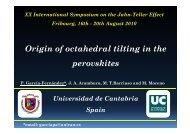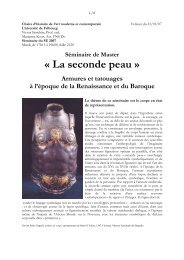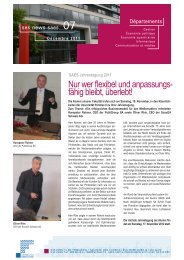POLINGER Victor
POLINGER Victor
POLINGER Victor
You also want an ePaper? Increase the reach of your titles
YUMPU automatically turns print PDFs into web optimized ePapers that Google loves.
VIBRONIC ORIGIN OF<br />
FERROELECTRICITY<br />
<strong>Victor</strong> Polinger,<br />
University of Washington, Seattle, USA<br />
Pablo Garcia‐Fernandez,<br />
Universidad de Cantabria, Spain<br />
Isaac B. Bersuker,<br />
University of Texas @ Austin, USA
• Introduction<br />
Outline<br />
• The Instability Theorem<br />
• Ferroelectricity in cubic perovskites (BaTiO 3)<br />
• Ab‐Initio Calculations of Instability<br />
• Non‐Vibronic Approaches<br />
• Conclusions
Introduction: Milestones in the theory of<br />
Ferroelectricity<br />
(understanding the mechanism)<br />
• Electrostatic theory (order/disorder of dipoles): Slater (1950)<br />
• Phenomenological approach (the concept of soft‐mode):<br />
Landau &Ginzburg (1946), Devonshire (1949);<br />
Anderson (1959); Cochran (1959)<br />
• Electron polarizability approach: Jaynes& Wigner (1950)<br />
• The vibronic theory (pseudo JT effect): Bersuker (1966)<br />
• One‐band anharmonicity (a long‐range theory): Aizy (1966)<br />
• Two‐band long‐range theories:<br />
Kristoffel&Konsin(1967); Girshberg&Tamarchenko (1976)<br />
• Combined long‐range/short‐range approaches:<br />
Girshberg&Yacoby (1997); Konsin&Sorkin (2009)
DIPOLAR INSTABILITY: Estimating Polarizability<br />
Lattice<br />
Polarization, pj���ijEj j<br />
Electron<br />
polarizability:<br />
polarizability: � � latt latt<br />
ij<br />
latt<br />
i j<br />
n En�E0 �<br />
�<br />
latt<br />
el<br />
(per one elementary cell)<br />
� �<br />
Its (under‐estimated value) is :<br />
�<br />
E � E ~ 0.01 eV, dQ ~ 4 D, � ~ 900 D<br />
n<br />
el el<br />
��ij � �<br />
el �<br />
n , n �,<br />
0<br />
n 0 d0 �el<br />
0 1 latt<br />
d n n d<br />
, � , ~ 1 eV, ~ 5 D, ~ 20 D<br />
d n n d QQ<br />
3<br />
D As a rule, next to lattice polarizability,<br />
900<br />
� ~ 50 3<br />
20 D<br />
Its (over‐erestimated) value is:<br />
(per one elementary cell)<br />
electron polarizability can be neglected.<br />
3<br />
3
THE INSTABILITY THEOREM:<br />
Picture the Problem. T → 0 K, , Q 0.<br />
At T → 0 K, the free energy, F = � �(Q) –TS,<br />
transforms into � �(Q), the ground‐state APES<br />
��H� HJT � � Q<br />
�Q<br />
�<br />
� �<br />
VQ n<br />
��H �<br />
�1 �Q��� � �0, � V � 0�<br />
� n<br />
, �, �<br />
n n<br />
At a small vicinity of Q = 0,<br />
perturbation theory applies: H = H 0 + H JT<br />
The perturbation: Ψ 0 is frozen Ψ 1 is Q‐dependent:<br />
n n<br />
0 � Q �0<br />
0<br />
�Q�� �0� � �Q� � � �<br />
0 1<br />
Hybridization<br />
The greater the energy gap, � � – � �, the better the perturbation theory applies.<br />
At no coupling, V n = 0, the electron wave function remains frozen.<br />
Induced by the (pseudo) JT coupling, Q‐dependent hybridization<br />
provides electrons the flexibibility to adjust and adiabatically follow<br />
nuclei.
THE INSTABILITY THEOREM:<br />
The Strategy of the Proof<br />
Second‐order perturbation theory gives: K � K0 � Kv<br />
K<br />
2<br />
��H� 0 � � 2<br />
Q<br />
�<br />
���0 0 0<br />
is positive?<br />
V<br />
2<br />
K ��� n �<br />
v<br />
, �,<br />
n n 0<br />
is negative!<br />
Since K 0 > 0, then K 0 + K v < 0 only due to the dominant contribution of K v< 0.<br />
Theorem (Bersuker 1980): Since K o> 0, only the<br />
vibronic contribution, K v< 0, can make lattice<br />
unstable.<br />
0.
ProvingK 0> 0<br />
Since H = H el‐nucl + H nucl‐nucl, we have K 0 = K el‐nucl + K nucl‐nucl<br />
•Two‐step rigorous proof for cubic crystals (Bersuker, 1988): [BaTiO 3 is cubic]<br />
� �<br />
2 4<br />
2<br />
el-nucl n n el-nucl 3<br />
n<br />
n n<br />
� �<br />
K � C 0 � H 0 � �e C � n �0<br />
(a) (b)<br />
•The general case (Polinger, 2010, unpublished):<br />
As<br />
Knucl-nucl<br />
K<br />
�2<br />
10 , neglect Knucl‐nucl. Then<br />
el-nucl<br />
Proving K el‐nucl> 0:<br />
K � K<br />
~ 0 el-nucl<br />
� � �eZ<br />
K 0 H Q 0 0 0<br />
Q Q Q<br />
2 2 2<br />
n<br />
el-nucl � 2 el-nucl � � � 2��0 � � �<br />
mn , rm �Rn �an<br />
In the integrals, the shift substitution, ρm � rm �anQ, rm �ρm �anQ<br />
transfers the Q dependence into the electron wave function:<br />
�r,0 � � � , Q�� � � � �Q� � � � � � ��<br />
2 2<br />
�<br />
�<br />
As �� , � 0 � � � 0 � � 0.<br />
��<br />
�Q<br />
Variational Principle: �Q� ~ Q H 2 � � H 2 � �<br />
0<br />
K �<br />
0<br />
nucl-nucl
Ferroelectricity in BaTiO 3<br />
In perovskites (e.g., BaTiO 3),<br />
ferroelectricity is initiated by local PJT dipolar distortions<br />
For a Ti 4+ center<br />
in the octahedral environment<br />
of six oxygen ions O2‐ the MO LCAO energy level<br />
diagram is:<br />
Nine states, t2g, t1u, and t2g*, are involved in the PJTE<br />
under the Ti4+ off-center<br />
(odd) displacements T1u, X, Y, and Z.
Ferroelectricity in BaTiO 3<br />
Approximate solution of the pseudo JT problem<br />
for a TM site in cubic perovskites<br />
In the TiO 8‐<br />
6 cluster, the linear PJTE is represented by a coupling<br />
matrix 9 9 with respect to three‐fold degenerate T1udisplacements X, Y, and Z. The secular equation includes three constants, K0, Δ,and<br />
z ��H� F � 2 p�(O) � � 3 dxz(Ti)<br />
��X� Assuming weak covalency , it yields nine roots<br />
ε(R). Populating the lowest six orbitals with the<br />
12 electrons, gives the following ground state<br />
APES:<br />
0<br />
� �<br />
1 2 2 2 2 2 2 2 2 2 2 2 2 2<br />
�R� 2 K0R 2 F �R X � F �R X � F �R X �<br />
� � � � � � � � � � � � � �
Ferroelectricity in BaTiO 3<br />
The pseudo JT effect is due to<br />
additional covalency gained by distortion<br />
In the undistorted configuration,<br />
the overlap 3d �(Ti)‐p �(O) is zero.<br />
By distortion, this overlap<br />
becomes non‐zero producing<br />
new covalence �‐bonding which,<br />
however, deteriorates the �‐bonds.<br />
Distortion is spontaneous when<br />
the �‐covalency gain is larger than<br />
the loss in � bonding.<br />
The whole effect is critically dependent on the nature of mixing �‐orbitals<br />
(the vibronic coupling constant, F, and the energy gap, Δ)<br />
versus inner bonding �‐orbitals(the force constant, K 0)
The shape of the APES of the Ti 4+ ion in BaTiO 3 is extraordinary:<br />
If 4F 2 /K0 >Δ (or EJT>Δ), the APES has<br />
(a) A maximum at Qx=Qy=Qz=0 (meaning instability);<br />
(b) Eight C3v minimaat |Qx|= |Qy|=|Qz|= along trigonal axes<br />
at a depth of � = 3Δ(Y + Y ‐1 )with Q0 = 2F/ K0 and Y =K0Δ/(4F2 2<br />
0<br />
);<br />
21 Q Y �<br />
2<br />
(c) Six C4v saddle points at Qp= Qq= 0, Qr= 2Q along tetragonal<br />
0 1�Y<br />
axesat a depth of �3=(2/3)�; (d) Twelve C2v saddle points at |Qp|= |Qq| 0<br />
Qr= 0 (p, q, r = x, y, z), along orthorhombic<br />
axeswith a depth �in between (b) and (c).<br />
� �
Some Numerical Results of the Vibronic Theory<br />
Applied to<br />
ATiO 3 (A = Ca, Sr, Ba) and BaMO 3 (M = Ti, Zr, Hf)<br />
Rough numerical estimates from band-structure calculations:<br />
CaTiO3 SrTiO3 BaTiO3 BaZrO3 BaHfO3 Kv ‐1.51 ‐1.33 ‐1.15 ‐0.20 ‐0.17<br />
K0 1.41 1.23 0.98 0.83 0.86<br />
K ‐0.10 ‐0.10 ‐0.17 0.63 0.69<br />
Regularly, SrTiO3 is an incipient ferroelectric, K 0.<br />
Strong isotope effect:Replacing 16O →18O changes SrTiO3 into a<br />
true ferroelectric with TC 24.5 K. (Itohet al. 1999)<br />
With 16O, the effective mass is m* = 24 u. With 18O, m* = 25.4 u.<br />
K 0<br />
Since �0 �<br />
, increasing m* reduces 0 and thus enhances the<br />
instability<br />
m *<br />
See similar in Yacoby and Girshberg, 2008
Ferroelectric BaTiO 3 versus Non-Ferroelectric ABO 3<br />
Why some cubic perovskites are not ferroelectric?<br />
1 2 2 2 2<br />
0�Q�� 2 K0Q �2� �F<br />
Q<br />
1 2 2 2 2 2 2 2<br />
, , �Q�� K Q �2� �F Q � � �F<br />
Q<br />
0 2 0<br />
Adding just one d electron reduces the PJT instability significantly.<br />
In BaVO 3, long‐range elastic forces prevail over the weakened PJTE.
Phases, phase transitions, and disorder dimensionality<br />
in BaTiO 3 and KNbO 3 type crystals<br />
predicted by the PJT theory of ferroelectricity<br />
Phases Rhombohedral Orthorhombic Tetragonal Cubic<br />
Direction of<br />
polarization<br />
[111] [011] [001] ‐<br />
Dimensionality<br />
of disorder<br />
0 1 2 3<br />
Number of<br />
minimum points<br />
involved in disorder<br />
2<br />
‐ [111] and [111]<br />
4 8<br />
Temperature of<br />
phase transition<br />
Tc(I) = 183 K Tc(II) = 278 K Tc(III) = 393 K<br />
Emerging from the pseudo JT coupling, the special shape of the<br />
APES allows for a direct interpretation of all the phases observed<br />
in BaTiO 3 and similar crystals
K = K 0 + K v<br />
Nature of ferroelectric phase transitions:<br />
displacive or order‐disorder?<br />
Short‐range versus long‐range driving forces<br />
��� Kv �� i, p<br />
��Hel� ph �<br />
0 � i,<br />
q<br />
� p<br />
� � � �0<br />
E0�Ei�p� ( � )<br />
��Kv<br />
�i, p�,<br />
i,<br />
p<br />
(a) Assuming weak �‐covalency (neglected in the zero‐order approximation)<br />
(b) Keeping �‐overlap of the wave functions for next‐neighbor atoms only<br />
(c) Looking for coupling to boundary optical phononswith q = 0(which results in<br />
p = 0), meaning mutual displacement of two sub‐lattices,<br />
we come to the following relation:<br />
K<br />
��� v<br />
2 2 2<br />
��H � � el-latt<br />
�V � � �V<br />
�<br />
0 � i, 0 i 0 i<br />
q<br />
� p �<br />
� Q<br />
� �<br />
Q<br />
�<br />
� � �0 �� � � �<br />
0 � � �0<br />
� � �<br />
� � � �<br />
, �, , �, , �,<br />
2<br />
0, p<br />
�p� �0� �0� i, p 0 i i, p 0 i i 0 i<br />
Pseudo JT effect is a local property. There are no long range forces<br />
in PJTE contribution to the instability. Long range forces are all<br />
included in K 0>0.
Experimental evidence of local origin of distortions and order‐disorder<br />
nature of phase transitions in "displacive" ferroelectrics<br />
Authors, year Method System Main result<br />
Comes, Lambert,<br />
&Guinier, 1968<br />
X‐ray diffuse scattering BaTiO 3 Qualitative confirmation of all the main<br />
predictions of the vibronic theory<br />
Quittetet al., 1973 Raman spectra BaTiO 3, KNbO 3 Polar distortions in cubic phase<br />
Burns, Dacol, 1981 Index of refraction BaTiO 3 Non‐vanishing component in cubic phase<br />
Gervais, 1984 Infraredreflectivity BaTiO 3 Qualitatively the same<br />
Ehseset al., 1981 X‐ray BaTiO 3 Strong order‐disorder component in<br />
cubic phase<br />
Itohet al., 1985 X‐ray BaTiO 3 [111] displacement of Ti in cubic phase<br />
up to 180 K above T C<br />
Mülleret al., 1986,<br />
1987, 1991, 2007<br />
Hanske‐Petitpierreet<br />
al., 1991<br />
Dougherty et al.,<br />
1992<br />
Stern et al., 1994,<br />
1998,<br />
Blinc, Zalar, &Laguta,<br />
2003, 2005<br />
ESR with probing ions Mn 4+ :BaTiO 3 [111] shift of Ti in the R phase and<br />
reorientations in O, T, and cubic phase<br />
XAFS KNb xTa 1‐xO 3 [111] shift of Nbin all phases for any x > 0.08.<br />
Femtosecond‐resolved<br />
scattering of light<br />
BaTiO 3, KNbO 3<br />
XAFS BaTiO 3, PbTiO 3,<br />
KNbO 3<br />
No relaxation mode found that might rule out<br />
the local distortion model<br />
[111] shift of Ti, Pb, and Nb in all phases<br />
including the cubic phase up to 200 K above T C<br />
NMR BaTiO 3 [001] shift of Ti in the cubic phaseup to 35 K<br />
above T C
NMR versus XAFX in BaTiO 3<br />
(Zalar et al., 2003; Stern 2004)<br />
[111]<br />
[100]<br />
[110]<br />
NMR for 47,49 Ti: In the C‐phase, at<br />
T< 420 K<br />
(by 20 K above the T ‐ C phase<br />
transition), the local cubic symmetry at<br />
the Ti sites lowers to tetragonal, [100]<br />
(Zalar, Laguta, &Blinc, 2003).<br />
In XAFS, in the C‐phase, in the interval<br />
35 K 10 ‐8 s.<br />
In XAFS, the averaging time, � < 10 ‐15 s.<br />
XAFS provides instantaneous snapshots<br />
of nuclei.
X- and Q-Band EPR in Mn 4+ :BaTiO 3<br />
(Völkel&Müller, 2007)<br />
197 K,<br />
T C (R → O)<br />
Temperature dependence of the line<br />
width at the X band<br />
The measured line broadening is fitted well<br />
by �B = �B 0 + a/(T 0 ‐ T) with T 0 � 233 K.<br />
Fast<br />
In the R‐phase, there are two processes with<br />
different time scale. One is fast, � 1 � 6ps.It<br />
forms a precursor to the O‐phase. Another<br />
one is slow, � 2 � 1000 ps.<br />
This line broadening is a direct indication that order‐disorder processes occur not only<br />
in the cubic phase, as detected by NMR, but also in the rhombohedral phase.<br />
The reorientation correlation time, � ‐‐1 � (T 0 ‐ T) with T 0 = 293 K, about 100 K higher than T C<br />
Fast
Coexistence of Order-Disorder and Displacive<br />
Dynamics in Ferroelectrics<br />
(Bussmann-Holder et al., 2009)<br />
Model 1D Hamiltonian: H = H latt + H ”el” + H ”el”-latt;<br />
g 2is parameter of polarizing “elasticity” of electron shells.<br />
Soft mode requires<br />
longer time<br />
Snapshots<br />
The “soft‐mode” feature can be observed<br />
at t > 1000 ps. At t < 1 ps, snapshots of the<br />
system are observed.<br />
Large clusters<br />
Small clusters<br />
The critical length scale as a function<br />
of T/T C.<br />
Both types of dynamics, order‐disorder and displacive, exist in parallel. Occurring in<br />
different length and time scale, in a single experiment, just one of the two component<br />
can be observed.
Arguing Against Criticism:<br />
Is the Energy Gap Too Large?<br />
In BaTiO 3, the populated O(2p) is separated from the empty Ti(3d) by a broad energy gap.<br />
Experimentally, the gap is about 3.2 eV (M. Cardona, 1965, & W. Wemple,1970)<br />
To induce instability the “pseudo‐degeneracy” condition must be satisfied: � < F 2 /K 0 .<br />
It was argued that the energy gap of � = 3.2 eV is too large to satisfy the condition<br />
of electron “pseudo‐degeneracy”.<br />
However, many molecules present even larger excitation energies and a strong PJT<br />
D 2d� D 2hrotation in ethylene involves a<br />
5 eV excitation (P. Garcia‐Fernandez, I.B.<br />
Bersuker et al. sent to PCCP 2010)<br />
CaF 2<br />
10.03 eV<br />
SrF 2<br />
9.17 eV<br />
BaF 2<br />
9.03 eV<br />
The bending of CaX 2 (X=F, Cl, Br) molecules<br />
involves excitations around 10 eV<br />
(P. Garcia‐Fernandez, I.B. Bersuker et al. JCPA 2007)
Electronic Structure Model Calculations<br />
First-Principles DFT calculations. Part 1: Small Clusters<br />
(Garcia‐Fernandez, ( 2010, unpublished) )<br />
Isolated complex Ti(OH) 6 8‐center complex: 2 2 2 cell<br />
Geometry optimization results in a<br />
polarized complex with trigonal<br />
symmetry C 3v. The central Ti 4+ is<br />
shifted off‐center in the direction<br />
[111], by 0.11 .<br />
The cluster includes H atoms at the surface, has a<br />
central Ba 2+ , and 6 more Ba atoms at the faces of the<br />
cluster. Geometry optimization:Ba atoms are fixed.<br />
Ti 4+ ions are off‐center shifted by 0.03 in opposite<br />
trigonal directions along the main diagonal.
Electronic Structure Model Calculations<br />
First-Principles DFT calculations. Part 2: Large Cluster<br />
(Garcia‐Fernandez, 2010, unpublished)<br />
27‐center complex: 3 3 3 cell The cluster includes 253 atoms with H atoms at the<br />
surface. Geometry optimization does not include Ba<br />
atoms. They are fixed at the respective cubic‐lattice<br />
experimental positions. In the optimization iteration<br />
procedure, each step moves ions by 0.001 .<br />
If all other Ti atoms are<br />
in their cubic position,<br />
for the central Ti, the<br />
APES has just one very<br />
shallow cubic minimum.<br />
Inter‐site dipole‐dipole coupling results in a stripe‐type<br />
ferro‐antiferro ordering. With a predetermined shifted<br />
position of some surface ions of Ti , the analysis does not<br />
support the assumption of dipole‐dipole coupling.<br />
The central ion Ti 4+ is off‐center shifted by about 0.11<br />
in one of the four trigonal directions along the main<br />
diagonal.
4 cells<br />
high<br />
Electronic Structure Model Calculations<br />
First-Principles DFT calculations. Part 3: Periodic calculations<br />
(Garcia‐Fernandez, 2010, unpublished)<br />
Unit cell<br />
.<br />
intermediate<br />
ferro anti<br />
x<br />
y<br />
z<br />
Frequency calculations for ferroelectric instability<br />
Cubic<br />
phase<br />
183i<br />
183i<br />
183i<br />
Tetragonal<br />
phase<br />
155i<br />
155i<br />
175<br />
Orthorhombic<br />
phase<br />
148i<br />
160<br />
160<br />
Rhombohedral<br />
phase<br />
153<br />
153<br />
181<br />
Calculations in ordered phases indicate that cubic, tetragonal<br />
and orthorhombic phases are unstable and thus not<br />
experimentally detectable<br />
antiferro<br />
intermediate<br />
ferroelectric<br />
Long‐range (dipole‐<br />
dipole) theories for<br />
ferroelectricity predict<br />
that no unstable<br />
antiferroelectric modes is<br />
not possible<br />
Non‐cooperative<br />
modes become<br />
unstable when the<br />
lattice is expanded
Electronic Structure Model Calculations<br />
First-Principles DFT calculations. Part 4: Periodic Cluster PbTiO 3<br />
(Choi et al. 2006 )<br />
Analysis of covalency at<br />
different points of the<br />
Brillouin zone<br />
Jahn‐Teller<br />
stabilization at<br />
different<br />
points of the<br />
Brillouin zone<br />
Electron density contour<br />
plots:<br />
(a) Total electron density<br />
(b) 3d z2(Ti) –2p x(O) hybrid<br />
states at the � point<br />
(c) 3d z2(Ti) –2p x(O) hybrid<br />
states at the X z point<br />
(d) hybrid states 3d zxz(Ti) –<br />
2p x(O) at the � point
Why Born Charges are So Big in Perovckite<br />
Ferroelectrics?<br />
( (Garcia‐Fernandez, , 2010, , unpublished) p )<br />
Born charges measure the change of the total<br />
polarization with the distortion<br />
dP<br />
Z*<br />
�<br />
dQ<br />
Born charges are a consequence of PJT effect<br />
P = ΣZ iR i+ <br />
The ground electronic state at the cubic phase is A 1g and it<br />
mixes with T 1u during the distortion thus<br />
Ψ = c A(Q)Ψ A+c T(Q)Ψ T<br />
P = ΣZ iR i+2c Ac T<br />
Thus all the electronic contribution to the Born Charge<br />
depends exclusively on the PJT effect<br />
In ferroelectrics Born charges are<br />
much larger than (usual) static<br />
charges<br />
Charge<br />
Nominal<br />
Mulliken<br />
Born<br />
Ti<br />
O<br />
Ti<br />
O<br />
Ti<br />
O(σ)<br />
O(π)<br />
BaTiO 3<br />
+4<br />
-2<br />
2.23<br />
-1.24<br />
7.38<br />
-5.85<br />
-2.12
Some Comments about The Non-<br />
Vibronic Approaches<br />
(a)The Ginzburg‐Landau theory<br />
(b)The electron polarization theory (used by non‐believers)<br />
� Polarization of ionic electron shells, �E � 10 eV<br />
(Exception: rare earth compounds)<br />
� Polarizing effect of electron hybridization, �E � 1 eV<br />
[Exception: electron (quasi) degenerate systems without inversion symmetry]<br />
(a)The adiabatic theories (used by half‐believers)<br />
� First‐principles calculation of the APES<br />
� The �4 theories
Polarization Model of Vanderbilt<br />
(Zhong, Vanderbilt, and Rabe, 1995)<br />
� �<br />
H � H � H �H<br />
The Hamiltonian: Strain<br />
n nm<br />
n n, m<br />
� �<br />
H �� u ��u �� u u �u u �u<br />
u<br />
2 4 2 2 2 2 2 2<br />
n 2 n n ny nz nx nz nx ny<br />
From the DFT‐LDA calculation (all in hartees),<br />
�2�0.0568, � �0.320, � ��0.473<br />
At these parameter values, the APES has just one shallow minimum<br />
at the origin, u nx = u nx = u nx = 0. Used by Zhong, Vanderbilt, and<br />
Rabe, the � 4 this model is not flexible enough to capture the multi‐<br />
minimum shape of the APES
Conclusions<br />
• The vibronic theory of ferroelectricity is the only first‐principles‐based<br />
approach that explains ferroelectricity by the specific character of<br />
chemical bonding in the respective substances.<br />
• Main predictions of the vibronic theory are supported by an<br />
impressive number of experiments.<br />
• In the vibronic theory, polar distortive forces have local nature. Local<br />
distortions are due to a gain in covalency between the transition metal<br />
and ligands.<br />
• The vibronic eight‐site order‐disorder model explains ordered low‐<br />
symmetry clusters and their partial order above TC. • The vibronic theory is a great tool in the search for new substances with<br />
tunable properties (multiferroics, etc.)<br />
• Eventually, the quiet truth of the vibronic theory of ferroelectricity<br />
will win!
Acknowledgements<br />
VP: Prof. Daniel Gamelin, Seattle, USA








